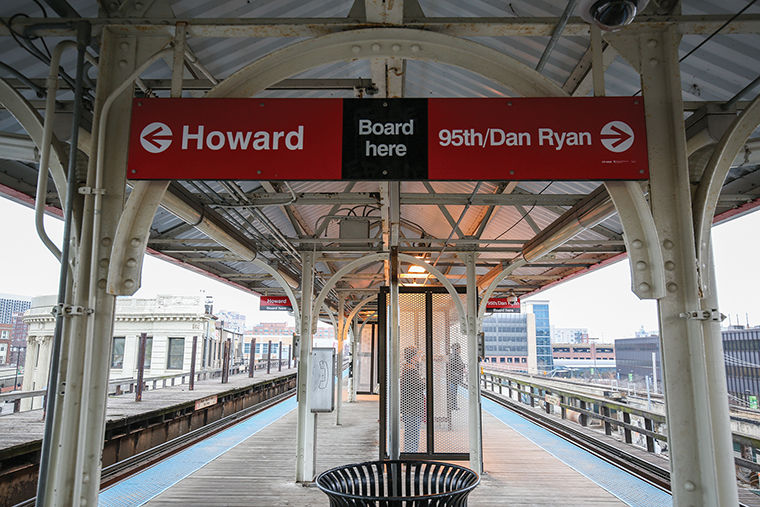Track, tech CTA upgrades in 2015
The Wilson Red Line stop in Chicago’s Uptown neighborhood will be under construction this year, a $203 million project set to be completed this spring, said CTA spokeswoman Ibis Antongiorgi. She said the platform will be renovated to serve as a new transfer point between the Red and Purple lines.
January 26, 2015
To improve daily commutes for Chi- cago residents, the Chicago Transit Authority is continuing a multiyear project geared toward addressing the problems many Chicagoans and commuting students often face.
As part of the $5 billion system improvement project announced by the CTA in 2011, 2015 upgrades will include initiatives to remodel rail stations on the Blue and Red lines, a Ventra smartphone appli- cation and improved subway wire- less access, CTA spokeswoman Ibis Antongiorgi said in a Jan. 19 emailed statement.
The Red Line’s 95th Street Ter- minal, originally built in 1969, will undergo a $240 million construc- tion project to expand and remodel
Antongiorgi said in the email. The station, which is one of the city’s busiest, serves more than 20,000 riders per day, the email said.
In addition to the 95th Street Terminal, construction will also continue on the Wilson Red Line stop. Antongiorgi said in the email that the $203 million project began in November 2014 and is expected to be completed this spring. The CTA will transform the dilapidated platform, creating a modern, accessible station that will serve as a new transfer point between the Red and Purple lines, she said in the email. Rebuilding the Wilson stop will benefit riders and boost economic development in the Uptown neighborhood, Antongiorgi added.
Some Blue Line stops will also get a facelift in 2015 with the continuation of a $492 million project that began last fall.
The CTA completed extensive track work and upgrades to the Blue Line between the Damen and Logan Square stops in 2014 to increase train speeds and improve reliability, according to the email. The California, Damen and Western stations, all built in 1895, were also renovated.
Original public artwork is scheduled for installation at the Damen stop in upcoming months, and more artwork will be installed at the California and Western stops in the fall.
Although the beginning date of the next phase of upgrades is yet to be announced, Blue Line riders can expect to see more modernized stations and faster service that will save passengers 10 minutes round-trip between downtown and the O’Hare stop, as well as the installation of elevators in certain stations, Antongiorgi said in the email.
With any major CTA project, commuting delays are to be expected during construction, but the CTA is finding ways to decrease such interference, according to the email.
“Every effort is made to minimize the impact to our customers and neighbors, which includes scheduling disruptive work late at night or on the weekends, when ridership is often at its lowest,” Antongiorgi said in the email.
Riders can check the CTA website and social media pages for updated information on service changes and planned service interruptions and to receive real-time updates and alerts of unexpected delays, Antongiorgi said in the email.
The CTA will also be upgrading subway wireless infrastructure to improve 4G service for underground riders. Riders should expect to see consistent and reliable connection in all CTA subway platforms later this year, Antongiorgi said in the email, adding that current wireless networks will remain operational while the upgrades are being made.
Drew Lodarek, a junior audio arts & acoustics major who frequently uses the Red Line, said better cellphone service in the subways will improve his commuting experience.
“There have been times where I’ll be in the subway and I won’t get any cell service,” Lodarek said. “That can be kind of a pain when you’re trying to communicate with people that are a few miles away and everyone is trying to converge on a single point.”
To make it easier for riders to pay fares, the CTA will be rolling out a Ventra smartphone application in 2015 that will allow CTA, Metra and Pace riders the ability to add transit value and passes to their Ventra card, check account balances and receive real-time account alerts, according to the email.
“[The app] will allow Metra riders, for the first time, to purchase and display tickets on their smartphones using a Ventra account or personal credit or debit cards,” Antongiorgi said in the email.
Dylan Middlebrook, a junior cinema art + science major who lives in Edgewater, said he reloads his Ventra fare card when semesters are not in session and U-Passes are deactivated. He said he plans to use the new application because it is more convenient than managing his card online or adding fare on the Ventra machines in rail stations.
“I would use it when I need to check how much money I have on my card because the only way I can check now is if I go on Ventra.com and I have to type in the 16-number code online,” Middlebrook said. “If I do it from my phone, that will make everything a lot easier.”








